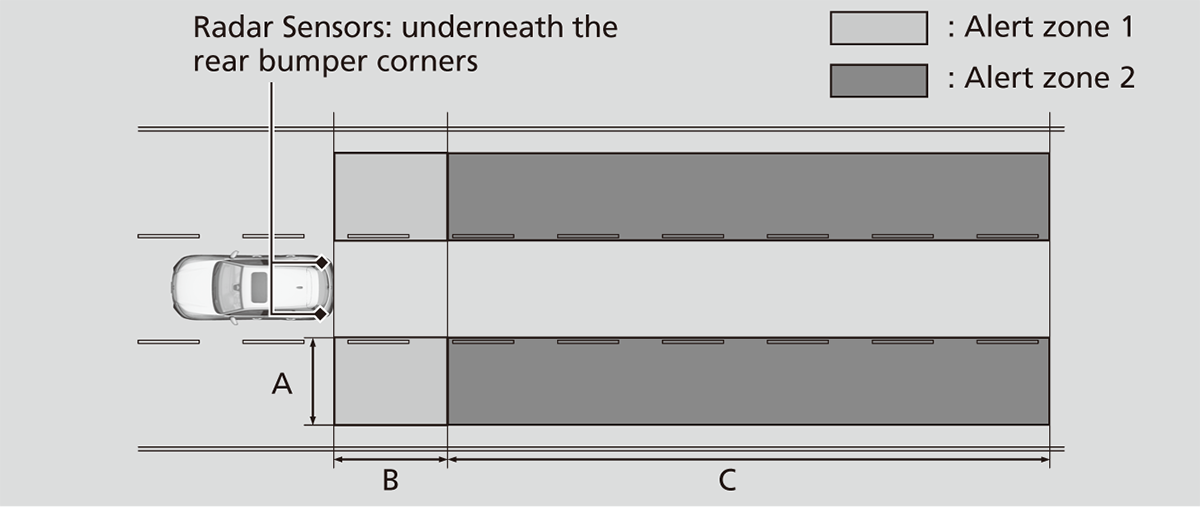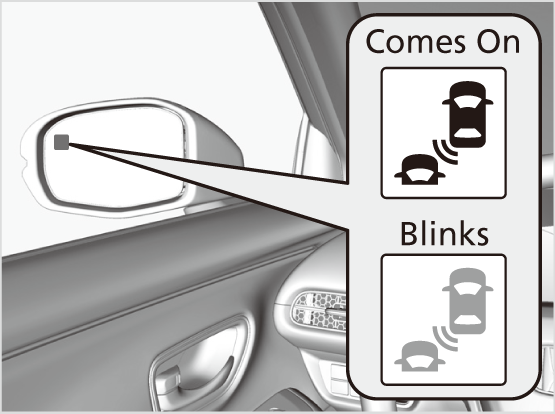Blind Spot Information System*
When the system detects vehicles approaching from behind in adjacent lanes, the appropriate indicator comes on, providing assistance when you change lanes.
- Detail
-
Important Safety ReminderLike all assistance systems, the Blind Spot Information System has limitations. Always look in your mirrors, to either side of your vehicle, and behind you for other vehicles before changing lanes. Overreliance on the Blind Spot Information System may result in a collision.Have your vehicle checked by a dealer in the following situations:
- The rear bumper or area around the radar sensors is strongly impacted.
- The indicator does not come on even if a vehicle in the alert zone should have been detected.
- The rear bumper or any system components need to be repaired.
If the rear bumper or any system components are repaired, the system will revert to alert zone 1 only until it is able to adapt and expand to alert zone 1 and 2.For proper Blind Spot Information System operation:- Always keep the rear bumper and area around the radar sensors clean.
- Do not cover the rear bumper corner area with labels or stickers of any kind.
The system is for your convenience only. Even if an object is within the alert zone, the following situations may occur:- The Blind Spot Information System alert indicator does not come on and the message Blind spot information system not available appears on the driver information interface.
- The Blind Spot Information System alert indicator may come on even with the message displayed.
You can change the settings for the Blind Spot Information System.
How the System works
The system activates when your vehicle is moving forward at about 20 mph (32 km/h) or above.

Alert zone range
A: Approx. 1.6 ~ 10 feet (0.5 ~ 3 meters) from vehicle side.
B: Approx. 10 feet (3 meters) from rear bumper.
C: Approx. 10 ~ 82 feet (3 ~ 25 meters) behind from rear bumper. (The faster the approaching vehicle, the further away it will be detected.)
The initially set alert zone is alert zone 1. Over time, after the vehicle has been driven on straight roads with traffic and roadside objects, the system will adapt and expand the alert zone (alert zone 1 and 2).
When the system detects a vehicle
-
Blind Spot Information System alert indicator: Located on the outside rearview mirror on both sides.
Comes on when:- A vehicle approaches you from behind to overtake you at a speed difference of no more than about 31 mph (50 km/h).
- You pass a vehicle at a speed difference of no more than about 12 mph (20 km/h).
Blinks and a beeper sounds when:You use the turn signal lever to signal a turn in the direction of the detected vehicle while the Blind Spot Information System alert indicator is on.
- The beeper sounds three times.
-

Blind Spot Information System On and Off
You can turn the system on and off using the driver information interface.
Switching the DisplaySafety Support
The Blind Spot Information System will stay on the previously selected on (checked) or off (unchecked) setting each time you start the engine.
Blind Spot Information System Conditions and Limitations
The Blind Spot Information System alert indicator may not come on under the following conditions:
- There is a large speed difference between your vehicle and the vehicle in the adjacent lane.
- A vehicle is parked in a side lane.
- An object not detected by the radar sensors approaches or passes your vehicle.
- The vehicle driving in the adjacent lane is a motorcycle or other small vehicle.
The Blind Spot Information System may not operate correctly under the following conditions:
- Making a turn at an intersection.
- Objects (guard rails, poles, trees, etc.) are detected.
- An object that does not reflect radio waves well or a motorcycle, is in the alert zone.
- Driving on a curved road.
- A vehicle is moving from a far lane to the adjacent lane.
- The system picks up signal interference such as other radar sensors from another vehicle or strong radio wave transmitted from a facility nearby.
- The rear bumper or the area around the radar sensors is covered by dirt, mud, snow, ice, etc.
- The rear bumper or the area around the radar sensors has been damaged or deformed.
- In bad weather (heavy rain, snow, and fog).
- Making a short turn or driving on a bumpy road that slightly tilts the vehicle.
- An object such as a bicycle rack is attached to the rear of the vehicle.
* Not available on all models
- Recommended topic(s)

